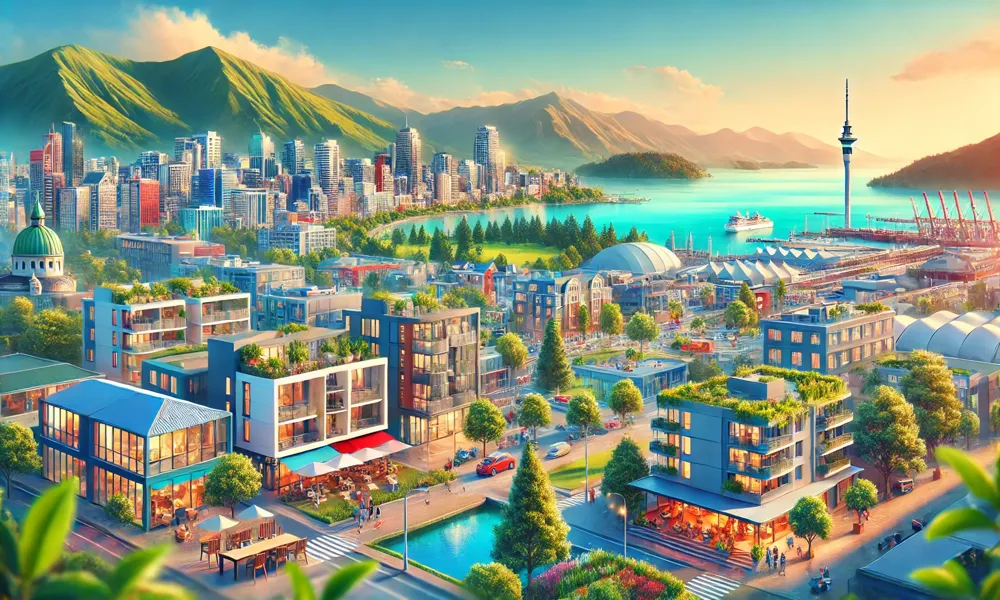Top 10 Best Places to Live in New Zealand
Table of Contents
New Zealand is known for its stunning natural landscapes, high quality of life, and welcoming communities. Whether you’re looking for a bustling city with job opportunities or a coastal town with a relaxed lifestyle, New Zealand offers something for everyone.
From the adventure capital of Queenstown to the cosmopolitan hub of Auckland, and the historical charm of Napier, each city has unique characteristics that cater to different lifestyles. Whether you’re a young professional or a family seeking a great environment to raise children New Zealand has a diverse range of locations that offer exceptional living standards, strong economies, and access to world-class education and healthcare.
In this guide, we explore the 10 best places to live in New Zealand in 2025, evaluating each city based on livability, job opportunities, affordability, climate, and lifestyle benefits. Let’s take a closer look at what makes these cities some of the best places to call home in New Zealand.
Best Places to Live in New Zealand
Queenstown
Queenstown is a breathtaking town located on the shores of Lake Wakatipu, surrounded by the majestic Southern Alps. Known globally as the “Adventure Capital of the World,” it is a paradise for thrill-seekers and nature lovers alike. The town is famous for bungee jumping, skiing, skydiving, jet boating, and mountain biking. In addition to its adrenaline-pumping activities, Queenstown offers a high quality of life, with its vibrant café culture, world-class wineries, and stunning alpine scenery. It is also a popular place for remote workers, retirees, and those looking for a lifestyle change. Below are the key details of Queenstown:
| Feature | Details |
| Population (2025 est.) | ~30,000 |
| Median House Price | $1,200,000 NZD |
| Average Rent (1-bedroom apartment) | $2,200 NZD/month |
| Climate | Oceanic – cold winters, mild summers |
| Key Industries | Tourism, Hospitality, Adventure Sports |
| Main Attractions | Lake Wakatipu, Remarkables Ski Field, Milford Sound, Skyline Gondola |
| Pros | Stunning scenery, outdoor lifestyle, strong tourism economy |
| Cons | High cost of living, seasonal job market, limited public transport |
Wellington
As the capital city of New Zealand, Wellington is not only the political hub but also a center of arts, culture, and innovation. Located on the southern tip of the North Island, Wellington is often referred to as “the coolest little capital in the world”. The city has a diverse and highly educated workforce, with many professionals working in film production (Weta Workshop), public administration, information technology, and creative industries. Despite its small size compared to Auckland, Wellington consistently ranks as one of the most livable cities in the world, thanks to its walkability, thriving economy, excellent public transport, and access to nature. Below are the key details of Wellington:
| Feature | Details |
| Population (2025 est.) | ~215,000 |
| Median House Price | $950,000 NZD |
| Average Rent (1-bedroom apartment) | $2,000 NZD/month |
| Climate | Windy, temperate climate with mild summers and cool winters |
| Key Industries | Government, IT, Creative Arts, Film Industry, Finance |
| Main Attractions | Te Papa Museum, Mount Victoria Lookout, Wellington Cable Car, Weta Workshop |
| Pros | Strong economy, vibrant arts scene, excellent public transport, walkable city |
| Cons | High housing costs, unpredictable weather (windy conditions) |
Auckland
Auckland, also known as the “City of Sails,” is the largest and most cosmopolitan city in New Zealand. Spanning across two harbors, Waitematā and Manukau, the city boasts stunning waterfronts, lush green parks, and volcanic landscapes. Auckland offers top-tier universities, major business headquarters, international airports, and a rich multicultural community. With over one-third of New Zealand’s population residing in Auckland, the city offers vast employment opportunities in finance, technology, media, education, and manufacturing. Below are the key details of Auckland:
| Feature | Details |
| Population (2025 est.) | ~1,700,000 |
| Median House Price | $1,100,000 NZD |
| Average Rent (1-bedroom apartment) | $2,500 NZD/month |
| Climate | Subtropical – warm summers, mild winters |
| Key Industries | Finance, Commerce, Healthcare, Tech, Tourism |
| Main Attractions | Sky Tower, Auckland Domain, Rangitoto Island, Viaduct Harbour |
| Pros | Strong job market, high-quality education, multicultural environment, mild climate |
| Cons | Expensive housing, traffic congestion, high cost of living |
Dunedin
Dunedin, located on the southeast coast of New Zealand’s South Island, is a city known for its rich Scottish heritage, Victorian and Edwardian architecture, and prestigious academic institutions. Often called the “Edinburgh of the South,” Dunedin is home to University of Otago, New Zealand’s oldest university, which brings a vibrant student population, and a strong research focus to the city. Beyond its academic reputation, Dunedin is known for its rugged coastlines, unique wildlife (such as the rare, yellow-eyed penguin) and low cost of living compared to other major urban centers. Below are the key details of Dunedin:
| Feature | Details |
| Population (2025 est.) | ~135,000 |
| Median House Price | $670,000 NZD |
| Average Rent (1-bedroom apartment) | $1,500 NZD/month |
| Climate | Temperate, cool winters, mild summers |
| Key Industries | Education, Healthcare, Tourism, Research |
| Main Attractions | Baldwin Street (steepest street in the world), Otago Peninsula, Larnach Castle |
| Pros | Affordable cost of living, strong education sector, beautiful heritage buildings |
| Cons | Cooler climate, smaller job market compared to bigger cities |
Christchurch
Christchurch, also known as the “Garden City” due to its expansive green spaces and parks, is the largest city in the South Island. Following the 2011 earthquake, Christchurch has undergone extensive urban redevelopment, emerging as a city with modern infrastructure, innovation hubs, and a strong commitment to sustainability. The city also serves as a gateway to outdoor adventure, with the Southern Alps, ski fields, and the Banks Peninsula just a short drive away. Below are the key details of Christchurch:
| Feature | Details |
| Population (2025 est.) | ~400,000 |
| Median House Price | $780,000 NZD |
| Average Rent (1-bedroom apartment) | $1,800 NZD/month |
| Climate | Mild summers, cool winters, occasional earthquakes |
| Key Industries | Technology, Tourism, Agriculture, Education |
| Main Attractions | Christchurch Botanic Gardens, Canterbury Museum, Banks Peninsula |
| Pros | Affordable housing (compared to Auckland), growing job market, strong community spirit |
| Cons | Earthquake-prone region, rebuilding process still ongoing in some areas |
New Plymouth
New Plymouth, located on the west coast of New Zealand’s North Island, offers beautiful black sand beaches, an active arts scene, and proximity to Mount Taranaki, making it an ideal location for outdoor enthusiasts who enjoy both the ocean and alpine landscapes. The city has a strong economy, largely supported by the oil and gas industry, agriculture, and tourism. New Plymouth is also home to the famous Govett-Brewster Art Gallery, a major cultural landmark showcasing contemporary art. Below are the key details of New Plymouth:
| Feature | Details |
| Population (2025 est.) | ~90,000 |
| Median House Price | $720,000 NZD |
| Average Rent (1-bedroom apartment) | $1,600 NZD/month |
| Climate | Mild oceanic climate with high rainfall |
| Key Industries | Oil & Gas, Agriculture, Tourism, Arts |
| Main Attractions | Mount Taranaki, Coastal Walkway, Govett-Brewster Art Gallery |
| Pros | Affordable living, scenic landscapes, strong local economy |
| Cons | Smaller job market, higher rainfall |
Rotorua
Rotorua, located in the Bay of Plenty region, is one of New Zealand’s most unique cities, known for its geothermal wonders, bubbling mud pools, geysers, and natural hot springs. The city also serves as a major center for Māori culture, offering visitors a rich cultural experience through traditional performances, historical sites, and indigenous cuisine. Rotorua is a tourism-driven city, with a strong focus on eco-tourism, adventure activities, and wellness retreats. Below are the key details of Rotorua:
| Feature | Details |
| Population (2025 est.) | ~80,000 |
| Median House Price | $680,000 NZD |
| Average Rent (1-bedroom apartment) | $1,500 NZD/month |
| Climate | Mild, geothermal activity influences local temperature |
| Key Industries | Tourism, Hospitality, Geothermal Energy, Forestry |
| Main Attractions | Whakarewarewa Thermal Village, Redwoods Forest, Polynesian Spa |
| Pros | Strong tourism economy, rich cultural experiences, natural hot springs |
| Cons | Sulfuric smell from geothermal activity, seasonal tourism-based economy |
Hamilton
Hamilton, located in the Waikato region, is one of New Zealand’s fastest-growing cities, known for its young population, vibrant economy, and excellent educational institutions. The presence of the University of Waikato has established Hamilton as a key education hub. The city offers a thriving nightlife, growing business sector, and a central location that makes it easy to explore both Auckland and other parts of the North Island. Below are the key details of Hamilton:
| Feature | Details |
| Population (2025 est.) | ~180,000 |
| Median House Price | $770,000 NZD |
| Average Rent (1-bedroom apartment) | $1,700 NZD/month |
| Climate | Mild, with moderate rainfall year-round |
| Key Industries | Education, Technology, Agriculture, Retail |
| Main Attractions | Hamilton Gardens, Waikato River Walk, Hobbiton (nearby) |
| Pros | Strong economy, excellent education facilities, affordable compared to Auckland |
| Cons | Less nightlife compared to bigger cities, frequent traffic congestion |
Napier
Napier, situated in Hawke’s Bay, is renowned for its distinctive Art Deco architecture, mild climate, and high-quality wine production. Following the 1931 earthquake, the city was rebuilt in a stunning Art Deco style, making it one of the best-preserved examples of this architectural movement in the world. Napier offers a relaxed coastal lifestyle, with beautiful beaches, vineyards, and a strong cultural scene. The Hawke’s Bay wine region is famous for its world-class reds and whites, making Napier a food and wine lover’s paradise. Below are the key details of Napier:
| Feature | Details |
| Population (2025 est.) | ~70,000 |
| Median House Price | $720,000 NZD |
| Average Rent (1-bedroom apartment) | $1,600 NZD/month |
| Climate | Warm summers, mild winters |
| Key Industries | Wine Production, Tourism, Agriculture |
| Main Attractions | Art Deco Festival, Hawke’s Bay Wineries, Marine Parade |
| Pros | Relaxed coastal lifestyle, great wine scene, unique architecture |
| Cons | Smaller job market, limited public transport options |
Nelson
Nelson, located at the top of the South Island, is known for its exceptional climate, stunning natural beauty, and thriving arts scene. With more sunshine hours than any other city in New Zealand, Nelson is a paradise for outdoor lovers. The city is surrounded by beautiful beaches, national parks (such as Abel Tasman National Park), and a strong creative community. Nelson’s economy is diverse, with key industries including tourism, arts and crafts, winemaking, and horticulture. Below are the key details of Nelson:
| Feature | Details |
| Population (2025 est.) | ~55,000 |
| Median House Price | $800,000 NZD |
| Average Rent (1-bedroom apartment) | $1,700 NZD/month |
| Climate | Sunniest city in New Zealand, mild winters |
| Key Industries | Tourism, Arts, Winemaking, Horticulture |
| Main Attractions | Abel Tasman National Park, Nelson Lakes, Tahunanui Beach |
| Pros | Stunning landscapes, warm climate, strong arts culture |
| Cons | Expensive housing, limited public transport |
Conclusion
New Zealand’s cities and towns each offer a unique blend of lifestyle, career opportunities, and affordability, making the choice of where to live highly dependent on personal priorities. Whether you prefer city life, coastal living, or a small-town feel, New Zealand’s clean environment, excellent public services, and high safety standards ensure a great quality of life no matter where you choose to settle. If you’re planning to move to New Zealand, consider your needs carefully, explore different locations, and find the city that best aligns with your dreams and aspirations.
Frequently Asked Questions
Which city in New Zealand has the best job opportunities?
Auckland offers the most job opportunities due to its large economy, with industries in finance, technology, healthcare, and commerce. Wellington also provides strong job prospects in government, IT, and film production.
Which city in New Zealand is the most affordable to live in?
Dunedin, New Plymouth, and Rotorua are among the most affordable cities in terms of housing prices and cost of living. They offer lower rent, affordable property prices, and good quality of life compared to major cities like Auckland and Wellington.
What is the safest city to live in New Zealand?
Nelson and Dunedin are considered among the safest cities in New Zealand, with low crime rates, friendly communities, and excellent healthcare services.
Which city has the best weather in New Zealand?
Nelson is known for having the most sunshine hours in New Zealand, making it one of the warmest and sunniest cities. Auckland and Napier also have mild climates with warm summers and moderate winters.



